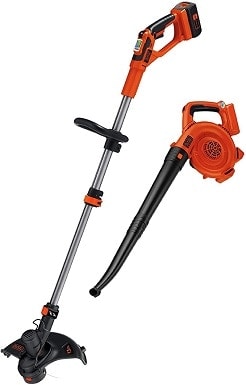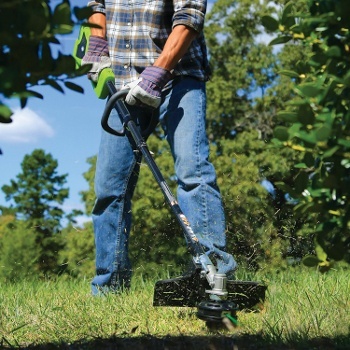5 Best Weed Eaters of 2025 – Top Picks, Reviews & Guide
-

- Last updated:


The good news is that the weed eater reviews and the buying guide in this article will help you find a good product without breaking a sweat.

Our Favorite Models Compared (2025 Update):
| Rating | Image | Product | Details | |
|---|---|---|---|---|
Best Overall
 |
 |
BLACK+DECKER LST136W |
|
CHECK PRICE |
Best Value

|
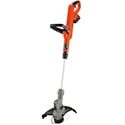
|
BLACK+DECKER LST300 |
|
CHECK PRICE |
Best Gas Option

|
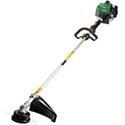
|
Hitachi CG22EAP2SL |
|
CHECK PRICE |
|
Best Commercial Option
|
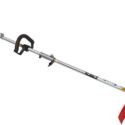
|
Tanaka TCG27EBSP |
|
CHECK PRICE |
|
|

|
BLACK+DECKER LCC140 |
|
CHECK PRICE |
The 5 Best Weed Eaters
1. BLACK+DECKER LST136W Weed Eater – Best Overall
The Black+Decker LST136W is the best battery-powered weed eater, and overall best weed eater on the market. Since it runs on a battery, and not a gas-powered motor, this machine is lighter and less noisy than gas-powered weed eaters. At the same time, this machine does not compromise on power.
Its trademark POWERDRIVE™ transmission transfers the power from the 40 V motor to the string efficiently. The POWERCOMMAND™ dial, another Black+Decker trademark, lets you vary the speed of the trimmer between 6500 RPM and 8500 RPM. So, you can set the machine to do high-power and short-duration tasks or to do low-power and long duration tasks.
The LST136W comes with a 1.5 Ah battery and a fast charger. The fast charger reduces the time needed to charge the battery by 2 hours. Now, you can charge your battery to 100 percent in an hour. The LST136W has an automatic feed system. So, you don’t have to bump your trimmer to adjust the string’s length.
Another great thing is the two-in-one operation. You can turn the cutting head to point vertically and use the machine as an edger. This machine is ideal for people who make weekly maintenance runs in their yards. However, if you own a large piece of land that requires a couple of hours to trim, the LST136W won’t help because it will run out of charge.
- POWERDRIVE™
- POWERCOMMAND™
- Lightweight and less noise
- Fast Charger
- 3-year warranty
- Trimmer/Edger two-in-one mode
- Not suitable for high-power use over long periods
2. BLACK+DECKER LST300 Weed Eater – Best Value
Although I wouldn’t call the LST136 expensive, the Black+Decker LST300 is more economical than the LST136. That’s why the LST300 is the best weed-eaters for the money. The main difference between the 136 and the 300 is the motor voltage.
The LST300 runs on a 20 V system. The maximum speed you can get on this machine is 6500 RPM. This speed is suitable only for low-intensity yard work. However, the LST300 has a 2 Ah battery. So, you can work longer before draining the battery.
The LST300 comes with the POWERDRIVE™ system that the LST136 has. The two machines also share the same automatic feed system. Plus, you can configure the LST300 to work as a trimmer or an edger. But, the LST300 does not come with a fast charger. Since this is a 2 Ah battery, it will take a few hours to charge it fully.
Perhaps the best reason to buy the LST136 is its price point. The price is ridiculously low for the features you get. If you’re a weekend-trimmer, this is the best low-cost weed wacker you can get.
- POWERDRIVE™
- Trimmer/Edger two-in-one operation
- Auto feed
- 2 Ah battery
- Suitable for only low-intensity yard work
- No fast charger
- Long charging time
- 2-year warranty
3. Hitachi CG22EAP2SL Weed Eater – Best Gas Option
Battery-powered weed eaters are fine as long as the weeds don’t hit back. But, sometimes the weeds don’t play ball. So, you to pull out the big guns, AKA gas-powered weed eaters. And the Hitachi CG22EAP2SL is one of the best gas weed wackers on the market.
Powered by a 21.1 cc PureFire two-stroke engine, this machine complies with emission levels without sacrificing power, adding extra weight, or creating maintenance issues. Its steel drive shaft ensures the power from the motor reaches the cutting head with minimal wastage.
The CG22EAP2SL has a 60-inch shaft. This allows you to work for longer periods without straining your back. The starting mechanism on this machine, called the S-Start, lets you turn the machine on effortlessly with just two or three pulls. Even with all the power coursing through the machine, the anti-vibration system gives you a sturdy grip and optimal control.
Unlike the Black+Decker machines, which have an automatic feed system, the feed system on the CG22EAP2SL is semi-automatic. You will have to bump-feed the machine as you go about trimming. Lastly, this trimmer comes with an industry-best 7-year consumer warranty. If you’re looking for moderate to heavy trimming across a large area, this is the trimmer for you.
- 21.1 cc two-stroke engine
- Steel drive shaft
- 60 inch shaft
- 7-year warranty
- S-Start starting mechanism
- Bump feed system
- 115 decibels at racing speed
- Requires ear protection
- More than twice as heavy as the LST300
4. Tanaka TCG27EBSP Weed-Eater – Best Commercial Option
So far, we’ve covered trimmers purpose-built for low to moderate-intensity trimming work. However, if you are commercially involved in the trimming industry, none of those machines will serve you well. What you need is a heavy-duty trimmer, and as far as heavy-duty trimmers go, the Tanaka TCG27EBSP is the best commercial weed wacker.
This machine’s incredible trimming force comes from a 26.9 cc commercial-grade PureFire two-stroke engine. The engine combines powerful performance with reduced fuel consumption and durability. And with the S-Start technology, switching the machine on is a breeze.
Its tap and go 5-inch cutting head holds 13 feet of 0.095-inch nylon quite line trimming line. The Quiet Line trimming line, made of a special copolymer, reduces noise by 50 percent. At racing speed, this machine produces 111 decibels. So, make sure you have adequate protection for your ears.
Since this is a commercial weed eater, it’s a given that you’re going to use it for long periods. Fortunately, the long shaft, padded handles, and anti-vibration system on the Tanaka reduces strain dramatically.
Like the Hitachi CG22EAP2SL, the Tanaka 746570 comes with a 7-year consumer warranty. However, if you’re a commercial user, the warranty is for only 2 years. This machine is way costlier than other models in this review. So, a warranty of 2 years is hardly optimal.
- 26.9 cc Commercial Grade PureFire two-stroke engine
- S-Start technology
- Padded handles and long shaft
- Excellent anti-vibration system
- Costly
- More than twice as heavy as a home use trimmer
- Commercial warranty is only for 2 years
- Requires ear protection gear
5. BLACK+DECKER LCC140 Weed Eater
The Black+Decker LCC140 is a popular combo pack. The combo pack consists of a LSW36 battery-powered sweeper and the Black+Decker LST136W Trimmer/Edger, our top pick. Now, think about it, the hard part of trimming your yard is not the trimming. It’s the cleanup that follows.
But, if you buy this amazing sweeper/trimmer combo, the cleanup process will be as effortless as the trimming. Unless your yard is small and doesn’t require frequent trimming, you can benefit from buying an electric sweeper.
Among electric sweepers, the LSW36 is a great choice. It’s powered by a 2 Ah lithium-ion battery. However, you have to use the same battery for the sweeper and the trimmer. Also, Black+Decker does not provide the combo kit with the fast charger that comes with the LST136W. So, charging the battery takes up to 6 hours.
Buying the sweeper and trimmer combo is nearly 50 percent cheaper than buying the machines individually. In any case, you’re the best judge of how useful an electric sweeper is to your workload.
- Very economical combo
- 2 Ah battery for trimmer and sweeper
- Trimmer has auto feed and trimmer/edger mode
- Sweeper produces gusts at 120 miles per hour
- 3-year warranty
- Battery does not come with fast charger
- Same battery for both machines
Buyer’s Guide – Choosing the Best Weed Eater
If there’s one thing that everyone knows about weeds it that they never stop growing. Turning your back on your yard for a couple of weeks is all it takes for weeds to muster their forces. If you have a yard that just won’t stay down, you need a weed eater.
A weed eater saves time and effort, making it easier for you to stick to a regular maintenance schedule. If you stick to a regular schedule, you can get the weeds young. This prevents them from maturing and producing seeds. Although this won’t permanently stop their return, it will certainly delay their comeback.
So, if you’re looking to buy a weedeater, the first place to begin is the type of weed eater.
What are the different types of weed eaters, and which one should I get?
People classify weedeaters into three categories based on their power source:
- Gas-Powered: A gas-powered weed eater has a two-stroke or a four-stroke engine that runs on gas. The power from the engine travels down the shaft and rotates the trimmer. These machines are more powerful than the ones running on electricity. But, they are heavier and noisier than the electric counterparts.
- Electric-Powered: An electric weed wacker powers its motor using electricity from a nearby outlet. The power from the motor goes down the shaft and operates the trimmer. These machines give powerful results and produce less noise. More importantly, as long as you have supply, you can run the machine. No need to refuel or re-charge. But, the length of the cord limits its range.
- Battery-Powered: A battery-powered weed eater houses a battery pack that supplies power to a motor. Since the motor is connected to the trimming head, the cutting power travels from the motor to the trimmer. Unlike electric-powered weed eaters, these machines are not limited by range. They are light and quiet. But, they lack the heavy-duty power and stamina of a gas-powered trimmer.
People also classify weed wacker into two categories based on their application:
- Home Use: If you want to do some of the yard work that you pay others to do, a home-use weed eater will meet your needs. The home use weed eaters aren’t built for heavy-duty work. A home use weed eater helps with the maintenance process. For clearing dense clumps of weed, you’ll need a heavy-duty commercial weed eater. But, you can hire someone to do a one-time job for you and then do the maintenance work yourself.
- Commercial: If a considerable amount of your income comes from cutting weed, then you’ll be using a weed wacker every day. And you’ll run the machine for many hours a day. Plus, people will hire you to clear weeds that they can’t. So, you’ll need a weed cutter that delivers industrial-grade performance. Weed eaters built to serve this kind of workload are called commercial weed wackers.
Now that you know the different types of weed cutter, let’s look at factors that are important to buyers.
What are the important things I should consider before buying?
There are seven factors you should consider before buying a weed eater. I’ll discuss them one by one. Let’s start with the first one:
- Location: If you’re cutting weed only at a fixed place, like your backyard, then you can select a weed eater based on the size of your yard. For very small areas, where electric supply is available, you can go for an electric weed cutter. If supply is a problem, you can go for a battery-powered weed eater. However, if your yard is so large that it takes more than an hour to trim, you should consider buying a gas-powered weed eater.
- Weeds: You should also consider the nature of weed in your yard. If they have thin stems, you can cut them with a battery-powered trimmer. However, if the weeds are thick and stubborn, you will need a gas trimmer to power through them.
- Frequency: If you trim your yard every fortnight, then you can get by with a battery-powered weed eater. However, if you do yard work once in three months, a battery-powered weed eater may not have enough power and endurance to finish the job. In such cases, go for a gas-powered weed eater.
- Noise Level: If you, or others around you, have a low tolerance to loud sounds, buying a gas-powered weed trimmer is not a good idea.
- Maintenance: Battery-powered trimmers have fewer moving parts than gas-powered weed eaters do. So, if you’re looking for a low-maintenance machine, go for a battery-powered one.
- Downtime: Generally, battery-powered machines are lighter than gas-powered machines. But, this can vary from model to model. However, battery-powered machines need a lot of time to recuperate after the battery runs out. On the other hand, you can get a gas-powered machine up and running within minutes by refueling it.
- Warranty: A warranty is a promise the manufacturer makes about the product’s quality. For example, Hitachi promises that their trimmers are so good that they will be free of manufacturing defects for 7 years. So, if you’re looking for a high-quality machine, go for the ones that offer a long warranty.
Based on the above limits, you can choose the best weed wacker for your needs.
Sounds good. What are my options?
There are many weed eaters in the market. Each comes with its own advantages and disadvantages. However, I’ve weighed the pros against the cons of most of the popular brands and selected five models for your consideration. So, the first place to begin is the product review section. You will most likely find what you’re looking for in one of these five trimmers.
But, if you want to search for more products, you can check out weed eaters from Greenworks, Toro, and Worx. Also, look at other products from Black+Decker and Hitachi.
Conclusion
When people set out to buy their first weed eater, they look for machines with higher cutting power. But, this is the wrong way to go about things. The cutting power on most of these machines doesn’t vary much.
So, instead of making your decision based on the cutting power alone, you should look at other aspects of the machine. For example, power source, noise level, runtime, downtime, vibration, build quality, comfort, weight, and control.
But, when you begin examining products at this level of detail, things get complicated. That’s why I’ve done my best to put it all together in one place. Hopefully, I have helped you make a good decision.
Before we finish, let’s look at the bottom line. First, if you’re a commercial user, get the Tanaka. It’s a world-class trimmer. If you’re a home user, buy the Black+Decker LST136W, our top pick for the best weed eater. If budget is a concern, you can take a step down to the Black+Decker LST300 without making many compromises. However, if you want a gas-powered weed trimmer for home use, get the Hitachi model.
Thanks to advancement in many fields, weed eaters have come a long way. Today, there are many good products available in every price range. With the right knowledge and guidance, you will definitely find a machine that suits you perfectly.
See Also:
Contents




